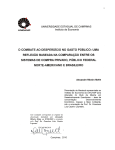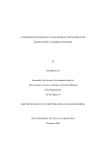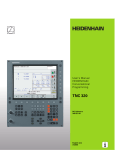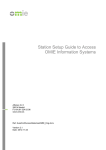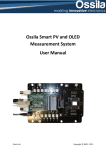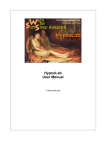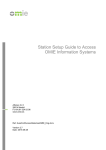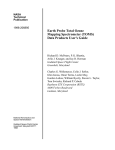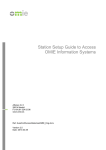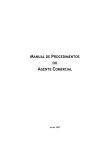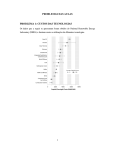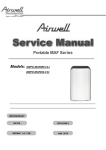Download OMNO2 Release Notes
Transcript
OMNO2 Release Notes Document Version 3.0: February 2009 Data Product Version 1.1.0.2 These Release Notes describe changes that have been made to the OMI NO2 data set, OMNO2. Only changes made since the provisional release (200511 21) are listed. Version 1.1.0.2, Starting with orbit number 24349, 2009.02.11 In previous versions, the wavelength registration check was executed for up to 10 wavelengths, and was done on rows 0, 30 and 59. It is now run on all rows, but on a smaller wavelength window. An extra parameter was added to the OPF for PGEA to indicate the desired fitting windows for the wavelength registration. The wavelength registration is no longer a check; it is applied as a correction to the L1B wavelength grid. The reason to do this now is the row anomaly observed in several cross track positions. The row anomaly has an influence on the radiance level. However, such a multiplicative error should not have an effect on the DOAS fit, and we observe a strong influence. The obstruction in the field of view causes an inhomogeneous illumination of the slit in the spectrometer, which in turn shifts the wavelength registration in OMI. Since the wavelength assignment in L1B does not use the position of various Fraunhofer lines in the radiance spectrum, this shift is not taken into account in the assigned L1B wavelength grid. For unaffected rows, the fitted shift is in the order of 0.002 nm on average. This is about 1/100 of a pixel. For affected rows, the shift can be up to 0.01 or larger (1/20 of a pixel). Including the shift reduces the error on the fit significantly, and the values for the affected rows are flat compared to the surrounding lines. In the northern hemisphere there is a second effect of the row anomaly. Here sunlight is coupled directly into the spectrometer. This is an additional error, and this is not taken into account or corrected for. In addition a new flag field 'XTrackQualityFlags' was added to the to carry forward the L1B flagging of the row anomaly. The meaning of this field is detailed in the following table: Value 0 1 2 3 Meaning • No error • Affected by row anomaly; • Pixel not corrected; • Do not use pixel. • (Slightly) affected by row anomaly; • Pixel not corrected; • Pixel can be used with caution. • Affected by row anomaly; • Pixel corrected, but correction is FitQualityFlags set QAF_OUTPIXEL_EARTH_RAD_ERROR (bit 2). QAF_OUTPIXEL_EARTH_RAD_WARNING (bit 3) QAF_OUTPIXEL_EARTH_RAD_WARNING (bit 3) not optimal; 4 • Use pixel with caution. • Affected by row anomaly; • Pixel is corrected for the row QAF_OUTPIXEL_EARTH_RAD_WARNING (bit 3) anomaly, and the correction is optimal; • Pixel is less accurate than pixels that are not affected by the row anomaly. 7 • Error during correction for row QAF_OUTPIXEL_EARTH_RAD_ERROR (bit 2). anomaly; • Do not use pixel Note that OMNO2A still processes all pixels, even those marked with a QAF_OUTPIXEL_EARTH_RAD_ERROR or QAF_OUTPIXEL_EARTH_RAD_WARNING bit due to the row anomaly. Because of the wavelength registration shift, the slant columns are still rather good (as DOAS does not depend too strongly on the absolute radiance level). Note however that the cloud product can still be heavily affected by the row anomaly, so further processing may still need to be changed to take the flags into account. Further documentation of the changes can be found in tech note TN_OMIE KNMI921 Version 1.0.5 (Collection 3), Released 2007.11.09 In this release, changes have only been made to the Level 1B processing (GDPS) and PGEA (OMNO2A). The Collection 3 Level 1B data have significant improvements over the previous version, leading to better quality fit results. The striping seen in Version 1.0.0, even after a “destriping” algorithm was applied, has been greatly reduced due to an improved dark current correction and improved QA flags. The DOAS fit residuals are much smaller, and the precision of the NO2 slant column is in line with estimates from the instrument noise. Specific changes to the Level 1B processing are detailed elsewhere. See the following references: 1 Dutch Space, “Ozone Monitoring Instrument for EOSAURA: OMI GDPS Software User Manual,” Document No. MAOMIE7000DS 459, Issue 6, 5 October 2007. 2 M. Dobber, Q. Kleipool, R. Dirksen, P. Levelt, G. Jaross, S. Taylor, T. Kelly, L. Flynn, G. Leppelmeier and N. Rozemeijer, “Validation of Ozone Monitoring Instrument level1b data products.” J. Geophys. Res., (in press). Changes that have been made in the Level 1B to Level 2A processing are as follows: 1. The order of the polynomial that is used in the DOAS fit to remove the background has been increased from 3 to 5. Analyses have shown that this increase in polynomial order decreases the error in the NO2 slant column density computed using a nonlinear fit. 2. The solar spectrum used to compute the Sunnormalized radiance in Version 1.0.5 is static. Version 1.0.0 had used a the daily measured solar spectrum. The static solar spectrum in version 1.0.5 is an average over all the daily Sun observations from OMI in the year 2005. Analyses have shown that using a static irradiance spectrum based on many observations resulted in much smaller dark current related stripes. 3. In Version 1.0.5 a water vapor spectrum has been added to the set of basis functions used in the DOAS fit. Analyses have shown that the water vapor columns derived from the DOAS fit were physically meaningful, and improvedthe quality of the retrieved NO2 slant columns. The same analyses showed that no physically meaningful O4 were obtained, when the O4 spectrum was included in the DOAS fit, and there was generally no improvement in the retrieved NO2 columns. For that reason, O4 is not included in the fit. 4. The reference cross sections of NO2, O3, O4, H2O and the Solar and Ring spectra have been updated, based on the latest version of the OMI onground measured slit functions. [Include a reference citation.] In addition, the water vapor spectrum has been updated to remove artifacts from the reference spectra. 5. Several smaller changes and bugfixes have been implemented. Version 1.0.0, Released 2006.09.08 Public Release (1) Level2 files now contain three main types of vertical column NO2 and estimates of their uncertainties. These are the observed total column (ColumnAmountNO2), the observed tropospheric (ColumnAmountNO2Trop) column, and observed polluted column (ColumnAmountNO2Polluted). The fields for the unpolluted column (ColumnAmountNO2Unpolluted) and its uncertainty (ColumnAmountNO2UnpollutedStd) now contain only fill values. As before, the smooth field is defined by the Fourier coefficients, which are included in the file. (2) The files also contain an estimate of the column amount hidden any clouds in the field of view (ColumnAmountNO2BelowCloud). This quantity – also called the “ghost column” - and its uncertainty are given for each OMI pixel with measurable pollution and a defined cloud fraction greater than zero. It is not a fixed quantity from a look-up table, but is computed from on the measured column amount and the a priori tropospheric profile shape. ColumnAmountNO2BelowCloud can be added to the total, tropospheric or polluted columns to obtain the respective complete columns, which are independent of cloud amount. However, the ghost column amount becomes less certain as the cloud fraction increases, particularly for cloud fractions > ~40%. Therefore, the user should carefully consider cloud information when selecting data for use in validation studies or other investigations. (3) A summary flag is now included with each observation to alert the user to the presence of one or more significant data quality issues. (4) Cloudy and clear components of the AMFs (both polluted and unpolluted) are now defined relative to the aboveground vertical column (previously they were relative to the visible column and thus contained cloud fraction information). The values of the radianceweighted sums of the clear and cloudy AMF components are unaffected by this change. (5) Uncertainty calculations for all quantities have been improved since the provisional release. Airmass factor uncertainties are now dependent on cloud parameters, terrain reflectivity and estimated a priori profile variability. In all calculations, cloudfraction uncertainty is fixed at ± 0.05. (6) The relationships among the column amounts and air mass factors in the current OMI algorithm are as follows: Au = w ּ Aucloudy + (1–w) ּ Auclear Ap = w ּ Apcloudy + (1–w) ּ Apclear Apobs = Ap ּ (Vp / Vpobs )│a priori Vpobs │a priori = f ּ Vpabove cloud│a priori + (1–f) ּ Vp│a priori Vinit = S / Au Unpolluted Case: V = Vinit Vtrop = Vinit ּ t Polluted Case: Vpobs = (Vinit – Vu) ּ (Au / Apobs) Vtropobs = Vpobs + Vu ּ t Vobs = Vpobs + Vu Vstrat = Vobs – Vtropobs Vghost = (Vinit – Vu )ּ (Au) ּ (1/Ap – 1/Apobs) Vp = Vpobs + Vghost Vtrop = Vtropobs + Vghost V = Vobs + Vghost In the above expressions, A is an air mass factor, V is a vertical column amount, S is a slant column amount, f is the effective cloud fraction, w is the cloud radiance fraction and t is the tropospheric fraction of the unpolluted column (about 0.05). The subscripts are p for polluted, u for unpolluted and init for initial. The air mass factor superscripts are clear for clearsky, and cloudy for overcast sky. The column superscripts are abovecloud (indicating integration from cloud top to infinity), and obs for the observed column (the column above cloud or ground that is visible to the satellite). Column amounts labeled a priori, were calculated by integrating an a priori NO2 profile. Vobs, Vpobs and Vtropobs are retrieved observed column amounts, and V Vp, Vtrop are the corresponding amounts above ground, computed by adding estimates of the belowcloud column to the visible column. Vu is the smooth unpolluted field from the planetarywave analysis. Version 0.9.1, Released 2006.05.15 (1) A bug was identified and fixed. The cloud reflectivity assumed when reading and interpolating the dAMF file was not consistent with the cloud reflectivity assumed in the Level2A cloud parameters from the O2O2 cloud algorithm. Prior to this version, a cloud reflectivity of 85% had been used in the OMNO2B algorithm, rather than the value of 80% assumed in the O2O2 cloud algorithm. A value of 80% is now assumed throughout the calculation. The effect of this change has not been quantified, but is expected to be minor.







